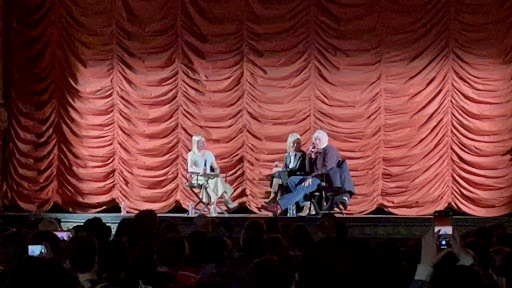Hats off to DePaul University for managing to consistently get a myriad of incredible
guest lectures and workshops for students. They recently had arguably the greatest living
cinematographer Sir Roger Deakins come in with his collaborator James Deakins for their
podcast/company “Team Deakins” to teach College of Digital Media students the tricks of the
trade when it comes to being a filmmaker, culminating in a sold-out screening at The Music Box
Theater with a film of his choice that her worked on along with a post screening Q&A. While
you would expect a film from The Coen Brothers (“Fargo,” “No Country for Old Men”) or maybe
Denis Villeneuve (“Prisoner,” “Blade Runner 2049”), he instead chose his one-time
collaboration with the director Andrew Dominik in the western biopic “The Assassination of
Jesse James by the Coward Robert Ford.”
Jesse James, played by Brad Pitt, is the closest thing to a real cowboy in American
history. A legendary outlaw with a mythic status surrounding him; known as the fastest gun in
the West, he naturally had a cult status surrounding him – particularly from a young man named
Robert Ford, played by Casey Affleck. After joining Jesse’s gang (which also has Robert’s
quipster older brother played by Sam Rockwell in their crew), Robert manages to slowly pull
them apart to become the next Jesse James. However, once things progressively go wrong, he
kills James out of fear and spends the rest of his days peddling the idea had done it out of
heroism.
What makes the film work are the visual language and the performances, as every actor
plays to their strengths. Brad Pitt is charismatic and domineering, Casey Affleck is meek and
deeply deceptive and Sam Rockwell is… pretty funny. They have a natural chemistry that
apparently according to Deakins had some scenes completely improvised in performance.
Speaking of, the cinematography. Scenes with either saturated yellows or icy blues,
bring this period piece to life with the help of an almost dreamlike approach to visuals. The
opening train robbery scene is hidden under layers of smog with golden yellows and velvety
reds. There is also the implementation of “Deakin Eyes,” a type of camera lens that Team
Deakins developed that mixes elements of fisheye, vignette, and light refraction. When used
with narration and insert shots, the scenes develop a dreamlike feeling and although Deakins
wanted to use it more during the production, the studio hated it so he begrudgingly stopped. It
forms a cumulative visual style that makes this one of the best looking Westerns I’ve ever seen.
Despite it being based on real events, these techniques give the film a completely foreign feel
as fi the audience is watching a dream, unfold in real time.
The only criticism of mine is the pacing. Deakins said that the first finished cut of this
two-hour and 40-minute film was a whopping four hours mentioning that most the cut material
was after Jesse James is actually killed, and boy does it feel like it. The first two hours are slow
and methodical to make the eventual betrayal hit harder, but the fallout of Ford’s actions is
played very fast and almost over relies on voiceover. The cuts feel particularly heavy when
everyone’s favorite “New Girl” Zooey Deschanel plays Ford’s future wife and is only given
maybe a minute and a half of screentime.
While the ending somewhat “jumps the shark,” the parable of Jesse James and Robert
Ford is nevertheless a gripping and entertaining film. Fingers crossed Deakins will do more
Westerns.
